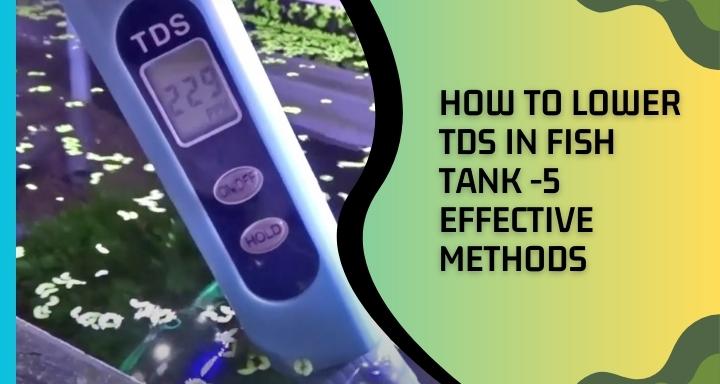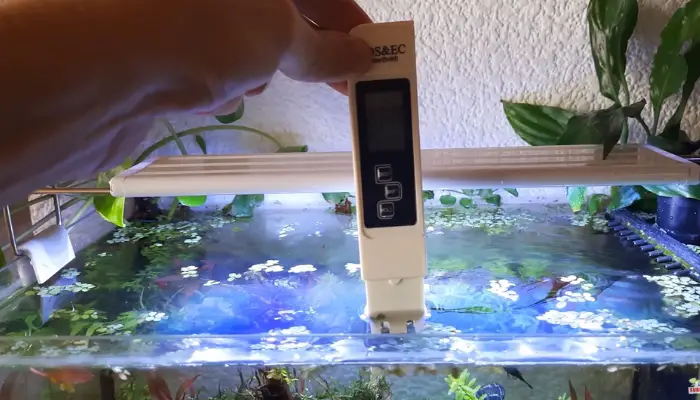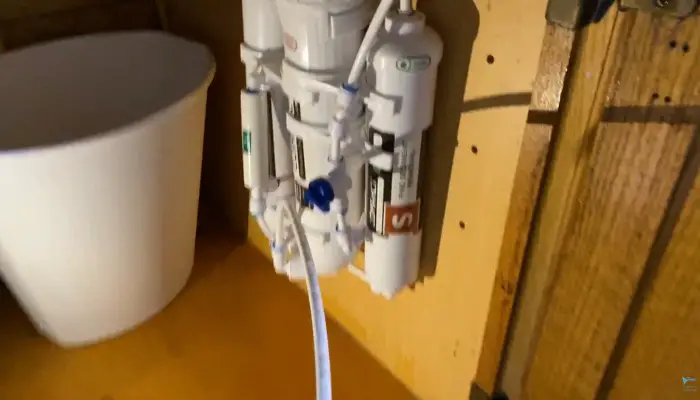
I think the most common problem that hobbyists face in aquarium maintenance is balancing the TDS level. Some common methods like performing a water change, using a reverse osmosis filter, using a deionization filter, using distilled water and reduced feeding can easily lower the TDS level in the fish tank.
But, most of the hobbyists in my surroundings cannot perform these activities properly. Luckily, one of my friends has been researching marine and aquatic life for several years. Consequently, I got much advice from him and applied it in my fish tank.
Then, I found the actual beauty of my fish tank. As an experienced hobbyist, now I can also provide you with techniques that were fruitful for me.
How to Lower TDS in a Fish Tank- Find the Easiest Way

1. Perform Water Changes
From my point of view, one of the easiest and most effective ways to lower the TDS in your fish tank is to perform regular water changes. If you want to continue this term, then follow the process as I do regularly.
Firstly, test the current TDS level of the tank water by using a TDS meter. This will give you a baseline for the current TDS level in the tank.
After that, Determine how much water needs to be changed. The amount of water you need to change will depend on the current TDS level, the desired TDS level, and the size of your tank. A general guideline is to change 10-20% of the water volume.
Next, prepare the replacement water. The replacement water should have a lower TDS level than the tank water. You can achieve this by using reverse osmosis (RO) water or a mix of RO water and tap water. Make sure the replacement water is at the same temperature as the tank water.
After that, remove the old water. Use a siphon or a gravel vacuum to remove the old water from the tank. Be careful not to disturb the substrate or decorations too much, as this can release more debris into the water.
Following removing water add the replacement water. Slowly add the water to the tank. It is important to do this slowly to avoid shocking the fish with a sudden change in water chemistry.
Again, test the TDS level. After the water change, test the TDS level again to make sure it has been lowered to the desired level.
Finally, monitor the tank. Keep an eye on the tank for the next few days to make sure that the fish is adjusting well to the new water conditions.
2. Use a Reverse Osmosis (RO) Filter

What would be next? Yeah! It’s about reverse osmosis filters that I am going to describe next. Like the water-changing mechanism, this process is also my favorite in the case of removing TDS. Let’s know about it.
Purchase an RO Aquarium Filter
Firstly, you have to purchase an RO filter from a local pet store or online. Make sure to choose an appropriate size for your aquarium and the amount of water you want to filter.
Install the RO Filter
Follow the instructions that come with your RO filter to install it. Typically, this involves connecting the filter to your water sources, such as a faucet or water line.
Flush the RO Filter
Before using the RO filter for the first time, it’s important to flush it to remove any impurities. Follow the manufacturer’s instructions to flush the filter.
Connect the RO Filter to Your Fish Tank
Once the RO filter is installed and flushed, you can connect it to your fish tank. This may involve using tubing to connect the filter to your aquarium or adding a separate container to store the filtered water.
Monitor TDS Levels
Use a TDS meter to monitor the TDS levels in your fish tank before and after using the RO filter. The ideal TDS level for most freshwater aquariums is below 500 ppm (parts per million). If your TDS levels are too high, continue using the RO filter until you reach your desired TDS level.
Replace Filters
The last suggestion about RO filters is replacing them. It’s important to replace the filters in your RO filter regularly to ensure it continues to work effectively. Check the manufacturer’s recommendations for how often to replace the filters.
3. Use a Deionization (DI) Filter
If you ask me how to lower TDS in an aquarium without ro or reverse osmosis, I can give you the idea of a deionization filter. Though it will cost higher than ro, it will provide a more effective solution for you. So let’s learn the mechanism of it.
There are two types of deionization filters- cation and anion exchange filters. Cation exchange filters remove positively charged ions, while anion exchange filters remove negatively charged ions. You can choose a filter based on the types of ions present in your water.
After that, you have to install the deionization filter following the manufacturer’s instructions. You will need to connect the filter to your water source using hoses or pipes.
Before using the filter, it is important to flush it with water to remove any impurities that may be present. This will help to ensure that the filter is working effectively.
Once the filter is installed and flushed, you can start using it to lower TDS. Simply turn on the water source and run the water through the filter. The filter will remove dissolved minerals and salts from the water, lowering the TDS level.
Next, your activity is to monitor the TDS levels before and after using the filter. This will help you to determine if the filter is working effectively and if you need to replace it.
But, remember, deionization filters have a limited lifespan and they will eventually need to be replaced. So, don’t forget to replace it after the specific time mentioned in the manufacturer’s instructions. Otherwise, it will result in the opposite as I suffered.
4. Use Purified or Distilled Water
I always love to use distilled water to maintain ideal tds for fish farming. In this case, firstly I test the current TDS level of my aquarium water using a TDS meter. This gives a baseline to work from.
Then, I determine the desired TDS level for my fish tank. This depends on the type of fish and plant in my aquarium. Before determining that, I consulted with a fish expert and did some research to find out the ideal TDS level for my fish tank. You should also maintain this fact.
Next, I purchase purified or distilled water from a reliable source. It is to be noted that do not use tap water as it may contain minerals and other impurities that can contribute to TDS levels.
Finally, I use purified or distilled water for partial water changes over time. Suggestions for you are, to start with small water changes and monitor the TDS level after each change. Gradually increase the frequency and amount of water changes until you reach the desired TDS level.
After completing these procedures I test the TDS level regularly and make adjustments as necessary. In this monitoring phase, if the TDS level is still too high, you may need to increase the frequency or amount of water changes. If it is too low, you may need to supplement the water with minerals or other additives.
But, to effectively lower TDS in an aquarium, you will need to perform partial water changes with purified or distilled water over time. Distilled water alone won’t reduce the TDS level effectively.
5. Reduce Feeding
Reduced feeding can play an important role in lowering TDS. Ideal TDS for freshwater aquariums can be maintained in this way easily. Hence, to make it fruitful, you have to provide only the amount of food that a fish needs to eat at one time.
The amount of food your fish need depends on their species, age, and size. Consult with a veterinarian or a knowledgeable fish store employee to determine the appropriate amount of food to feed your fish.
Then, feed them in small amounts of food at a time, rather than one large feeding. This means, feeding them less but frequently. This can help reduce the amount of uneaten food that accumulates in the tank.
Also, observe your fish closely to see if they are eating all the food you provide. If there is leftover food after a feeding, try reducing the amount of food you give them. At the same time, clean the uneaten food from the tank by using a fish net. This can prevent it from breaking down and increasing TDS levels in the water.
Finally, use a TDS meter to regularly test the water in your fish tank. This can help you monitor TDS levels and make adjustments to feeding and other factors as needed.
What Causes High TDS in a Fish Tank
If you don’t know the causes of high TDS in a fish tank, you can’t maintain the ideal TDS for freshwater aquariums or fish tanks, or other aquariums. That’s why check the reasons that may create barriers to lower TDS in a fish tank.
Overfeeding
Excess food can break down and create organic waste. Thus the TDS level is increased in the fish tank and creates problems for you.
Poor Water Quality
Poor water quality can cause high TDS in your fish tank. This can be caused by to lack of maintenance, overstocking or inadequate filtration which is devastating for the fish tank.
Mineral-rich Tap Water
If the tap water used for aquariums is high in dissolved minerals such as calcium, magnesium, and sodium, it can increase TDS. This is why I prohibited you to use tap water previously.
Use of Certain Substrates or Decorations
Certain substrates or decorations, such as crushed coral or limestone, can release minerals into the water and increase TDS.
Medication or Supplements
Adding medications or supplements to the aquarium water can also increase TDS. That’s why I always prohibit to use of any chemicals in the tank water.
Signs of High TDS in a Fish Tank
In the case of high TDS, you will notice some changes in your fish tank. Such changes will assure you of the excessive TDS level in your tank. Why not check the signs that ensure high TDS?
Increased pH
High TDS levels can raise the pH of the water. As you know, high pH makes the water too alkaline. Much alkalinity is detrimental for some species of fish and plants to survive.
Damage to Equipment
High TDS levels can cause damage to several pieces of equipment in the tank. These include filters, heaters, and pumps. As a result, it leads to higher maintenance costs.
Reduced Oxygen Levels
High TDS levels can reduce the oxygen level in the water. Oxygen is the main element for survival. Such a decrease in oxygen levels leads to the suffocation of fish and other aquatic creatures.
High Mortality Rate
You won’t love to see your fish dying inside the fish tank, right? But fish may die more frequently in a tank with high TDS levels. Due to the negative impact on their immune systems, fish may be weakened and they become more susceptible to disease.
Stunted Growth
High TDS levels can stunt the growth of fish. It will make them smaller than they would be in a healthier environment. It will demolish your tank’s beauty.
Skin and Gill Irritation
Along with the other problems, high TDS levels can irritate the skin and gills of fish, leading to health problems such as infections.
What is a Good TDS Level in a Fish Tank
Meanwhile, you have studied the causes and ways of how to keep TDS low in an aquarium. Here I want to suggest a TDS aquarium chart where you can learn what the TDS of the aquarium should be. It will also help you to keep the TDS level in perfect balance.
| Water tank | Perfect TDS level |
| Reef tank | 0-10 ppm (parts per million) |
| Saltwater aquarium | 35-45 parts per million (ppm) |
| Freshwater aquarium | 150-250 ppm (parts per million) |
| Brackish aquarium | 1000-3000 ppm (parts per million) |
| Planted aquarium | 150-300 ppm (parts per million) |
| Nano aquarium | 50-250 ppm (parts per million) |
| Coldwater aquarium | 150-500 ppm (parts per million) |
It is a recommended ideal TDS chart for different fish tanks. But it may vary according to your inhabitants and other terms. So if you feel confused, feel free to ask me or consult any fish specialist.
How to Lower TDS in a Shrimp Tank
The TDS level of a shrimp tank may vary from the TDS level of a fish tank in various cases. I have researched some shrimps recently and found an ideal TDS level for neocaridina shrimp is 150-300 ppm. That’s why I want to provide you with a glance at how to lower TDS in a shrimp tank.
Water Changes
One of the most straightforward ways to lower TDS in a shrimp tank is to perform regular water changes. It’s recommended to change around 10-15% of the water weekly to maintain optimal water conditions.
Use RO (Reverse Osmosis) Water
RO water is filtered water that removes most of the impurities and dissolved solids. Using RO water for water changes or top-ups can help reduce TDS levels.
Reduce Feeding
Overfeeding can lead to a build-up of organic matter, which can contribute to the TDS level in your tank. Make sure to feed your shrimp the right amount of food, and remove any uneaten food after a few hours.
Use Purigen or Activated Carbon
Purigen or activated carbon can help remove dissolved organic matter, which contributes to the TDS level. These can be added to your filter or placed in a mesh bag in your tank.
Check Your Substrate
The substrate in your tank can also contribute to the TDS level. If you’re using a mineral-rich substrate, it can increase the TDS level. You can consider switching to a substrate with a lower mineral content.
You will get some similarities and similarities between shrimp tanks and fish tanks. Still, if you want clear knowledge, I will suggest that in a new article later.
FAQs
How can I test the TDS levels in my fish tank?
You can purchase a TDS meter. It will give you a digital readout of the TDS levels in your fish tank. Alternatively, you can take a water sample to your local fish store and ask them to test it for you.
Can adding salt to a fish tank increase TDS levels?
Yes, adding salt to a fish tank will increase TDS levels, as salt is a dissolved solid. However, adding salt can also have benefits for fish, such as promoting healthy gill function and reducing stress. It is important to use salt in moderation and to monitor TDS levels regularly.
How often should I perform water changes to lower TDS levels?
The frequency of water changes depends on the TDS levels in your fish tank and the specific needs of your fish and other aquatic life. In general, it is recommended to perform a 25% water change every two to four weeks or more frequently if TDS levels are high
Final Words
Finally, I have to end here. The vast knowledge that I gained from my research and experience, I have shared here. If you have any suggestions on this writing, feel free to share them with me. Else, if you want suggestions about other topics, you can also ask me.
Let me mention here, the ways of reducing calcium, phosphate, and salinity levels are updated on my website. Overall, keep your aquarium clean and maintain the proper health issues. Thus, you can have a beautifully decorated fish tank.
- Top 15 Freshwater Aquarium Plant Ideas for a Lush, Green Tank - November 9, 2024
- Top 13 Freshwater Aquarium Layout Ideas for a Beautifully Organized Tank - November 9, 2024
- 14 Stunning Rustic Freshwater Aquarium Ideas for a Tranquil Environment - November 9, 2024
